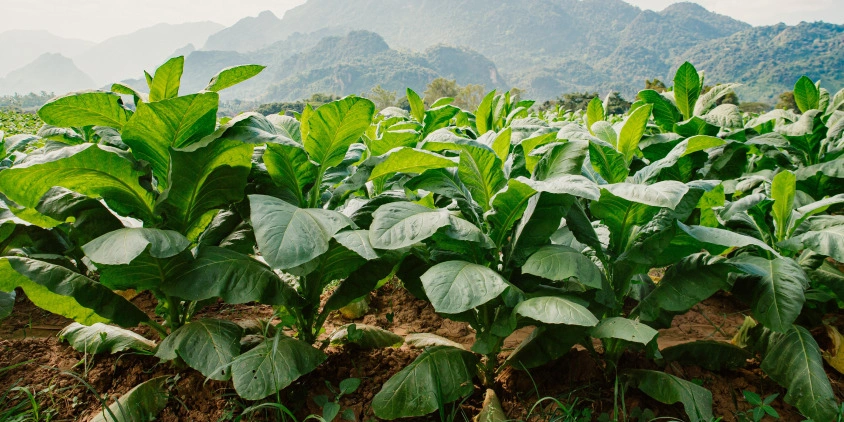
Growing Tobacco: From Planting To Harvesting And Curing
The process of growing tobacco starts way before planting, with field and variety selection. This is because planting a random crop variety in a random field does not guarantee producing a marketable product. However, a well-planned combination of crop variety, growing conditions, particularly soil, and cultivation practices — most notably fertilization and watering — lays the groundwork for an abundant, marketable harvest.
Commercial tobacco farming now integrates digital platforms for weather monitoring, nutrient management, crop rotation, and irrigation control, which bring precision to previously manual, guesswork-guided processes. Growing tobacco remains complex, but with proper knowledge and techniques, farmers can produce consistent, high-grade leaves.
The Best Conditions For Growing Tobacco
While the crop adapts to various climates, it is most productive in subtropical growing regions with warm days and cool nights. The plant grows best in deep, well-aerated soils and benefits from consistent moisture levels throughout the growing season.
What Climate Does Tobacco Grow In?
The crop needs temperatures between 70°F and 85°F (21°C to 29°C) and humidity of around 60–70% during most of the growing season. Light exposure is another critical factor. The crop needs at least 6 hours of full sunlight daily. Without these conditions, you’re risking poor leaf quality and reduced yields.
When you manage multiple fields, choosing the most climatically suitable ones and keeping track of all the critical weather parameters can become a real headache. EOSDA Crop Monitoring helps here: you can check both historical data for smart field selection and get up to 14-day forecasts for each specific location. Using field-specific weather data means you can make informed decisions before problems arise. The platform tracks temperature, humidity, and solar radiation — basically everything you need to know to keep your tobacco growing optimally.
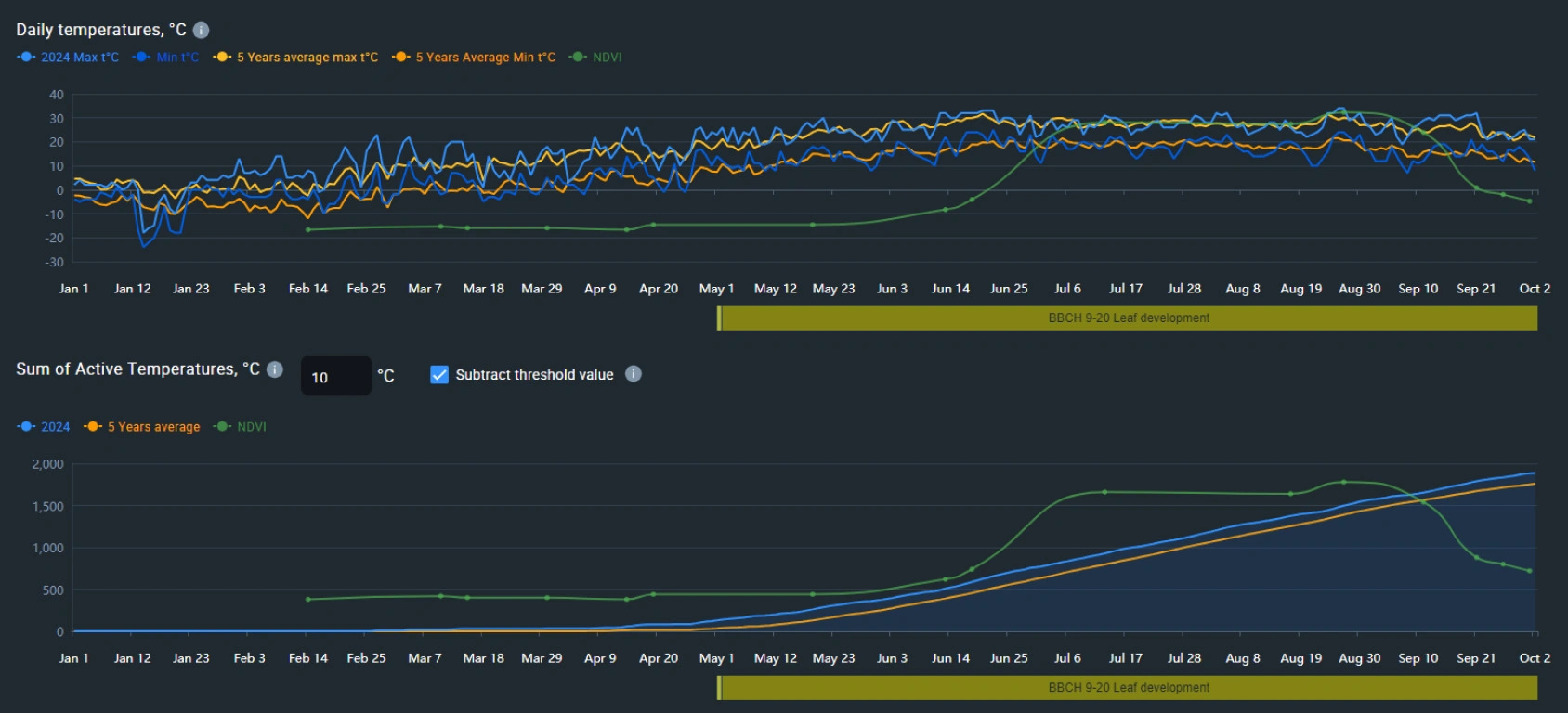
What Soil Does Tobacco Grow In?
Generally, the best soil for growing tobacco plants is well-drained, with adequate air circulation, as the plants can’t handle waterlogged conditions. The ideal soil pH falls between 5 and 6.5 (acid soils). High soil salinity can negatively affect both the quantity and quality of the yield, especially by deteriorating the texture of the leaves .
Here’s an overview of the recommended soil types based on the intended curing and processing methods for the harvested plants:
- light, sandy soil for flue-cured light leaves;
- silty to clay loam for air-cured dark leaves;
- loam, sandy or silty loam for fire- and air-cured light leaves.
After you’ve picked out a field that might suit farming tobacco, the next step is to select a variety and start planting.
How To Plant Tobacco?
Successful growers synchronize their greenhouse seeding dates with historical last-frost data, typically starting about two months before their target field transplant window. They aim to grow compact, hardy seedlings with thick stems and well-developed root systems. These seedlings are typically moved to the field with precision transplanters that assure constant depth and spacing with minimal transplant shock.

Selecting Tobacco Variety To Grow And Planting Seeds
Different varieties suit different end products, from cigarettes and cigars to chewing and hookah tobacco. However, the target market isn’t the only criterion in deciding which variety to grow. Tobacco growing requirements are comparable, if not more significant, criteria. Understanding these requirements allows agribusiness players to choose the most profitable variety based on their local climate and soil type.
| Variety | Days to grow | Soil | Climate | Water | Pest and disease resistance |
|---|---|---|---|---|---|
| Virginia | 90–130 | Light loam | Warm, sunny, moderately humid | Moderate; sensitivity to waterlogging | Moderate resistance to aphids |
| Burley | 100–130 | Deep, nutrient-rich loam | Mild | High — early in the growing season; lower — during maturation | Susceptible to blue mold and black root rot |
| Oriental | 85–110 | Sandy | Hot and dry (Medi-terranean) | Low, drought tolerance | High disease resistance |
| Havana | 80–100 | Nutrient-rich, well-drained loam | Tropical to subtropical | Moderate, steady irrigation | Moderate pest resistance |
Once you’ve decided which tobacco variety to grow, it’s time to plant the seeds. Small and fragile, these seeds are best started indoors and given 8–10 weeks to grow and strengthen before being moved outdoors. Plant seeds shallowly in germination trays filled with fine soil. Keep the soil consistently moist and maintain a warm environment to support growing seedlings.
Transplanting Seedlings
Once seedlings achieve a height of 6 inches (15 cm), usually within 6–8 weeks from seeding, they’re ready for field placement. Successful growers monitor soil temperatures, initiating transplant only when readings stabilize above 65°F (18°C) to ensure normal root development.
Space plants 24 to 28 inches (61 to 71 cm) apart within rows, with 36 to 48 inches (91 to 122 cm) between rows. This arrangement not only facilitates the efficient use of standard tobacco cultivation equipment but also ensures adequate space for root expansion and foliar growth.
How To Care For The Growing Tabacco?
Commercial tobacco growing relies on effective fertilization, as the crop’s high nutrient demands can quickly deplete even rich agricultural land. Well-planned crop rotation and other integrated pest management (IPM) techniques help protect plants from pests and diseases and prevent yield losses. It is also important to moisten crops sufficiently because either a severe deficit or excess of water can deteriorate the leaf quality. 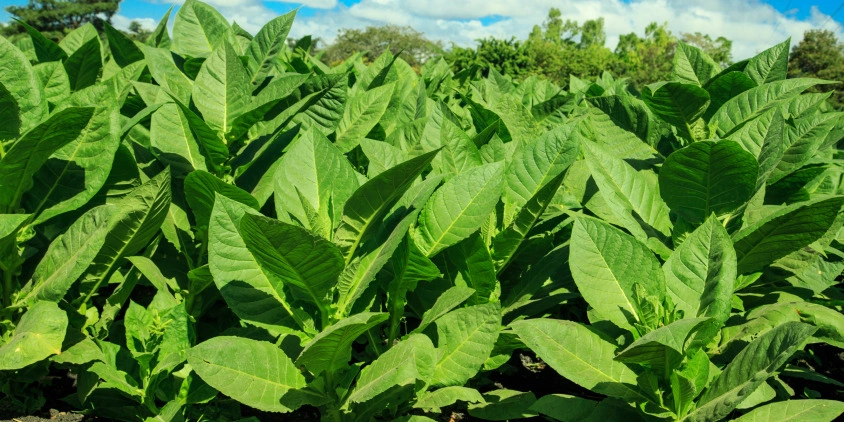
Tobacco Fertilizer Recommendations
Tobacco, a nutrient-hungry plant, has varying nutrient requirements throughout the growing season. Early in the growing season, plants benefit from nitrogen fertilization to support leaf development, while later they require potassium fertilization for improved chemical content and burn characteristics of leaves. Common tobacco fertilizer application methods include broadcast spreading for pre-plant and band placement for side-dress treatments.
Large-scale crop producers often struggle to manage nutrients efficiently and sustainably across vast tobacco growing fields. Satellite-based VRA maps in our crop growth monitoring system (both for nitrogen and for phosphorus and potassium applications) give farmers the tool for precise nutrient management. Variable rate technology maps segment fields into zones based on how densely the plants grow there to reveal:
- areas with insufficient vegetation, which require more fertilizer to prevent growth-limiting deficiency;
- areas with adequate and abundant vegetation, which require less fertilizer to prevent nutrient leaching or buildup.
EOSDA Crop Monitoring creates prescription maps in various formats, making them compatible with your existing farm equipment.

Tobacco Pests And Diseases
Tobacco growing still faces constant challenges from pests and diseases, which can reduce both crop yield and quality and affect farmer livelihoods across the globe. However, modern farmers can use satellite monitoring and soil sensors to spot pests and diseases early on, complementing and supporting traditional biological, chemical, and cultural practices. Below, you’ll find a comprehensive breakdown of the crop’s major pests and diseases and proven IPM measures.
| Pest/Disease | Causal agent | Control |
|---|---|---|
| Tobacco hornworms | Manduca sexta |
|
| Aphids | Myzus nicotianae Aphis gossypii |
|
| Cutworms | Agrotis ipsilon |
|
| Blue mold | Peronospora tabacina |
|
| Black shank | Phytophthora nicotianae |
|
| Root rot | Pythium spp. Fusarium spp. |
|
We’ve seen that managing tobacco plant diseases often involves crop rotation. The Crop rotation feature in EOSDA Crop Monitoring helps track when and which crops are grown in a particular field/fields. With this information, you can easily break pest and disease buildup in your fields and create a more sustainable crop protection strategy.

Tobacco Irrigation
Commercial varieties require precise water control throughout the growing season, with peak demand occurring 50–70 days post-transplanting. Water requirements vary significantly across growth stages:
- Germination. Apply light, frequent watering. Consider implementing a controlled water deficit during pre-transplant establishment to enhance drought resilience.
- Active growth. Maintain consistent, moderate irrigation. Water stress during this phase of growing tobacco can significantly impact yield potential and leaf development.
- Maturation. Reduce water application. Mild water stress helps limit new leaf growth, focusing plant resources on existing leaves.
Poor irrigation management can lead to substantial crop losses. Waterlogging for over 48 hours often results in severe damage or even plant death, while inconsistent watering affects leaf quality and market value . Commercial growing increasingly relies on drip irrigation systems, which offer precise water delivery directly to the root zone, minimizing waste and preventing oversaturation.
Modern field management software enables growers to optimize irrigation schedules. By integrating the Weather forecasts and the Field activity log available in EOSDA Crop Monitoring you can better schedule water applications and track irrigation activities across multiple fields, which means meeting most of the crop requirements across large-scale productions.

How Long Does Tobacco Take To Grow?
The crop usually takes 90 to 130 days to go from transplant to harvest. Havana varieties take the shortest time to grow (80 to 100 days), while Burley varieties take the longest (100 to 130 days). Growing conditions also influence the time to harvest. For example, low tobacco growing temperatures, nutrient deficiency, and moisture shortages during the mid-vegetative stage might delay the time it takes for crops to reach maturity.
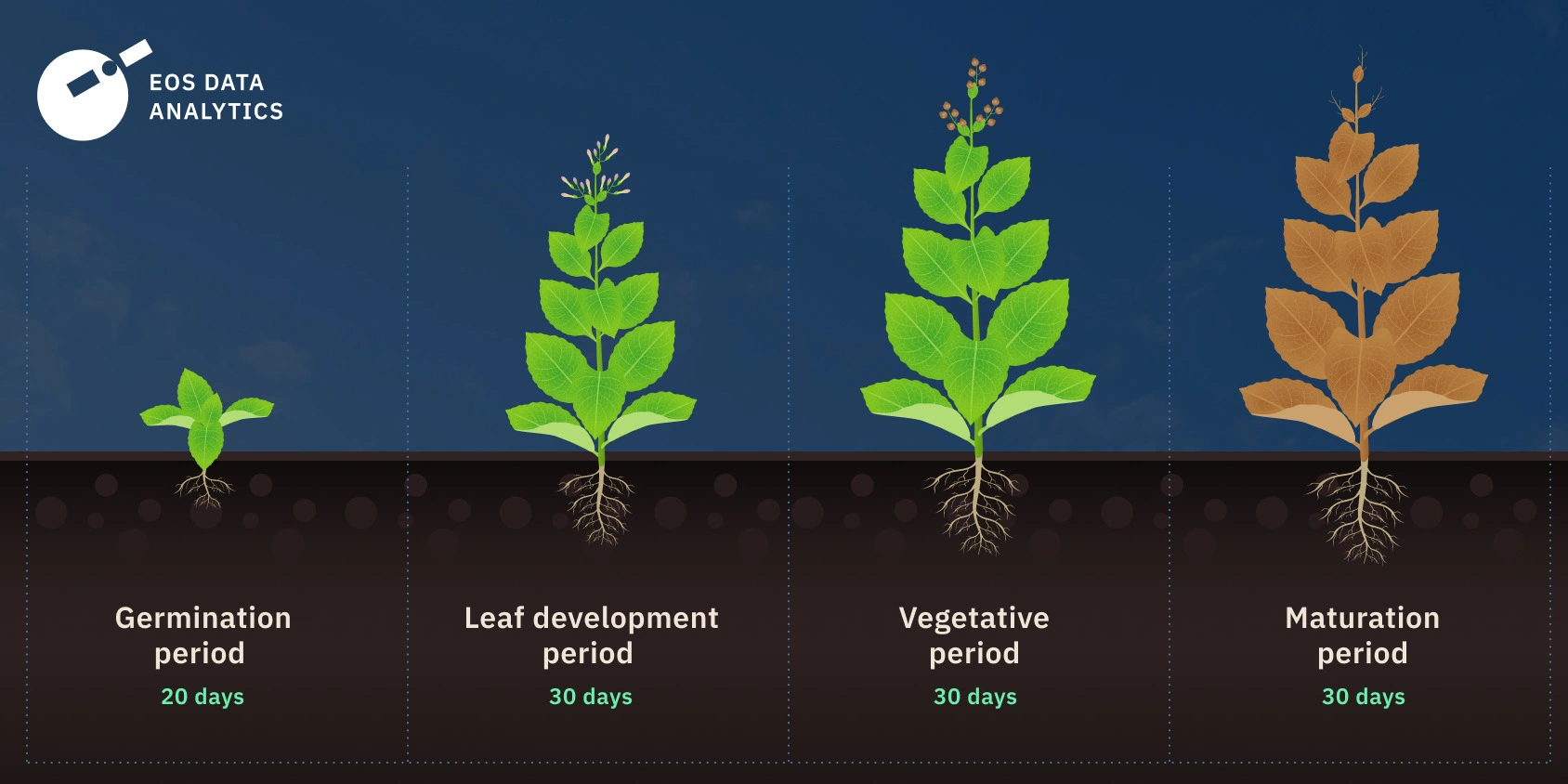
Tobacco Harvesting And Curing
Yellowing leaves and increased brittleness indicate tobacco ripeness — time to cut the plant or start priming. Once picked, leaves go through a 6-8-week curing process where controlled temperature and humidity transform the leaf chemistry for the desired color, texture, and flavor.
When And How To Harvest Tobacco?
When the leaves change from a vibrant green to a softer yellow-green shade and crack audibly when folded, it means the tobacco is ready for harvesting. This timing, typically 2–3 months after transplanting, varies among crop varieties and growing conditions. Peak ripeness occurs within a narrow window of 5–7 days. Harvesting during this period maximizes nicotine content and leaf quality. Modern harvest monitoring solutions assist growers in optimizing their harvesting timeline and estimating yield.
Two methods of harvesting tobacco are:
- Whole plant cutting. The whole plant is cut at the base, and the stalk is split for hanging. This method is commonly used for burley varieties.
- Priming. Leaves are selectively removed as they mature, typically progressing from the bottom to the top of the plant. This precise approach is standard for Virginia and oriental varieties, ensuring optimal quality for each leaf.
How To Cure Tobacco?

Different market segments demand specific leaf characteristics, driving producers to master various curing (drying under certain conditions) techniques. Large-scale producers typically maintain several curing capabilities to serve multiple market channels and quickly adapt to changing demand trends.
Common tobacco curing methods include:
- Air curing is a 4-8-week process in temperature-controlled barns. This traditional method requires significant storage space but gives high-quality control.
- Flue curing is an accelerated 7-10-day process in precisely regulated heat. Popular for cigarette leaf production due to its scalability and consistent output quality.
- Sun curing is a natural drying lasting 2-4 weeks. This weather-dependent but cost-effective method is mostly used for aromatic oriental varieties and organic-certified products.
- Fire curing is a 3-6-week process involving hardwood smoke exposure. This method, requiring specialized facilities and expertise, creates distinctively flavored leaves for specific product categories.
Modern tobacco curing facilities use automated systems with humidity and temperature sensors to monitor and instantly adjust curing conditions. A grower’s success in the market is directly proportional to their capacity to reliably provide high-quality, properly cured tobacco.
About the author:
Vasyl Cherlinka is a Doctor of Biosciences specializing in pedology (soil science), with 30 years of experience in the field. He attended the engineering college in Ukraine and received his degree in agrochemistry, agronomy and soil science in the Chernivtsi National University. Since 2018, Dr. Cherlinka has been advising EOSDA on problems in soil science, agronomy, and agrochemistry.
Recent articles
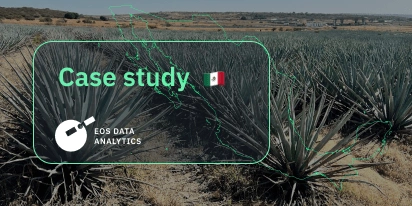
Digital Tools Improve Soil Health And Yields In Mexico
EOSDA and ITTA supported a Guanajuato farm with contour-line planning, monitoring tools, and practical guidance to reduce soil erosion and improve yields in the long run.

Analyze 2025 & Plan Your Best Year Yet: LandViewer Christmas Offer
It’s the most wonderful time of the year! The Christmas holidays are here, and so is your chance to analyze 2025 and plan a prosperous 2026 with more affordable Pro plans in LandViewer.
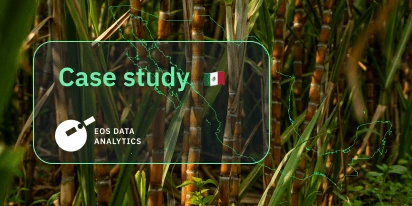
EOSDA Models Climate Change Impact On Sugarcane Yields
EOSDA modeled future temperature, rainfall, and other climate impacts on Veracruz sugarcane. The results help growers plan long-term adaptation strategies, including timing, varieties, and irrigation.